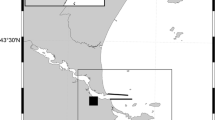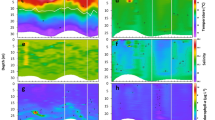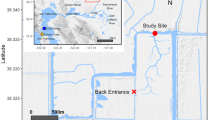Abstract
We investigated the vertical and temporal distributions of portunid zoea andCallinectes megalopae in a tidal pass of the Texas coast. Zoea were equally abundant on ebb and flood tide but were more abundant during the day than at night. Megalopae were more abundant during flood tide and at night than during ebb tide or during the day. We examined the evidence for selective tidal stream transport in both life-history stages. Depth of the centers of mass of the larval distributions and the dispersions around those centers were unrelated to temperature, salinity, current velocity, and time of day. Scaling arguments suggest that the absence of pattern in the vertical distributions was not due to turbulent mixing. There was little evidence that either larval stage used these environmental characteristics as cues for changes in behaviour. However, the presence of megalopae in the water column primarily during flood tide does support the tidal transport hypothesis. Megalopae may have difficulty sensing and reacting to environmental cues in wellmixed estuaries with semidiurnal tides.
Similar content being viewed by others
Literature Cited
Bookhout, C. G. andJ. D. Costlow, Jr. 1974. Larval development ofPortunus spinicarpus reared in the laboratory.Bulletin of Marine Science 24:20–51.
Costlow, J. D. andC. G. Bookhout. 1959. The larval development ofCallinectes sapidus Rathbun reared in the laboratoryBiological Bulletin 116:373–396.
Costlow, J. D. andC. G. Bookhout. 1966. The larval development ofOvalipes ocellatus (Herbst) under laboratory conditions.Journal of the Elisha Mitchell Scientific Society 82:160–171.
Cronin, T. W. andR. B. Forward, Jr. 1979. Tidal vertical migration: An endogenous rhythm in estuarine crab larvae.Science 205:1020–1022.
Csanady, G. T. 1982. Circulation in the Coastal Ocean. D. Reidel Publishing Company, Holland.
Darnell, R. M. 1959. Studies of the life history of the blue crab (Callinectes sapidus Rathbun) in Louisiana waters.Transactions of the American Fisheries Society 88:294–304.
Daugherty, F. M., Jr. 1952. The blue crab investigation 1949–1950.Texas Journal of Science 4:77–84.
De Vries, M. C., R. A. Tankersley, R. B. Forward, Jr., W. W. Kirby-Smith, and R. A. Luettich, Jr. 1994. The abundance of estuarine crab larvae is associated with tidal hydrologic variables.Marine Biology.
Epifanio, C. E., C. C. Valenti, andA. E. Pembroke. 1984. Dispersal and recruitment of blue crab larvae in Delaware Bay, U.S.A.Estuarine, Coastal and Shelf Science 18:1–12.
Forward, R. B., Jr. 1989. Behavioral responses of crustacean larvae to rates of salinity change.Biological Bulletin 176:229–238.
Goodrich, D. M., J. van Montfrans, andR. J. Orth. 1989. Blue crab megalopal influx to Chesapeake Bay: Evidence for a wind-driven mechanism.Estuarine, Coastal and Shelf Science 29:247–260.
Johnson, D. F. andK. W. Hess. 1990. Numerical simulations of blue crab larval dispersal and recruitment.Bulletin of Marine Science 46:195–213.
King, B. D., III. 1971. Study of migratory patterns of fish and shellfish through a natural pass.Texas Parks and Wildlife Department, Technical Series 9:1–54.
Little, K. T. 1990. Mechanism for the reinvasion of the Atlantic blue crab,Callinectes sapidus (Rathbun), into the Delaware estuary.Bulletin of Marine Science 46:247.
Little, K. T. andC. E. Epifanio. 1991. Mechanism for the reinvasion of an estuary by two species of brachyuran megalopae.Marine Ecology Progress Series 68:235–242.
Luckenbach, M. W. andR. J. Orth. 1992. Swimming velocities and behaviour of blue crab (Callinectes sapidus Rathbun) megalopae in still and flowing water.Estuaries 15:186–192.
Maris, R. C. 1990. Dispersal-recruitment mechanisms ofCallinectes sapidus Rathbun involving larval and postlarval patterns of diel vertical distribution in the vicinity of the Chesapeake Bay, Virginia, U.S.A..Bulletin of Marine Science 46:247.
More, W. R. 1969. A contribution to the biology of the blue crab,Callinectes sapidus, in Texas, with a description of the fishery.Texas Parks and Wildlife Department, Technical Series 1:1–26.
Perry, H. M. 1975. The blue crab fishery in Mississippi.Gulf Research Reports 5:39–57.
Provenzano, A. J., Jr.J. R. McConaugha, K. B. Philips, D. F. Johnson, andJ. Clark. 1983. Vertical distribution of first stage larvae of the blue crab,Callinectes sapidus, at the mouth of Chesapeake Bay.Estuarine Coastal and Shelf Science 16:489–499.
Sandifer, P. A. 1975. The role of pelagic larvae in recruitment to populations of adult decapod crustaceans in the York River Estuary and adjacent lower Chesapeake Bay, Virginia.Estuarine, Coastal and Shelf Science 3:269–279.
Scheltema, R. S. 1975. Relationship of larval dispersal, gene-flow, and natural selection to geographic variations of benthic invertebrates in estuaries and along coastal regions.Estuarine Research 1:372–391.
Sulkin, S. D. and C. E. Epifanio. 1986. A conceptual model for recruitment of the blue crab,Callinectes sapidus Rathbun, to estuaries of the Middle Atlantic Bight, p. 117–123.In G. S. Jamieson and N. Bourne (eds.), North Pacific Workshop on Stock Assessment and Management of Invertebrates. Canadian Special Publication Fisheries and Aquatic Sciences 92.
Sulkin, S. D. andW. Van Heukelem. 1982. Larval recruitment in the crab,Callinectes sapidus, an amendment to the concept of larval retention in estuaries, p. 459–476.In Victor S. Kennedy (ed.), Estuarine Comparisons. Academic Press, Inc., New York.
Sulkin, S. D., W. Van Heukelem, P. Kelly, andL. Van Heukelem. 1980. The behavioral basis of larval recruitment in the crab,Callinectes sapidus. A laboratory investigation of ontogenetic changes in geotaxis and barokinesis.Biological Bulletin 159:402–417.
Tagatz, M. E. 1968. Biology of the blue crab,Callinectes sapidus Rathbun, in the St. Johns River, Florida, U.S.A.Fishery Bulletin 67:17–33.
Tankersley, R. A. and R. B. Forward, Jr. 1994. Endogenous swimming rhythms in estuarine crab megalopae: Implications for flood tide transport.Marine Biology.
Ward, G. J., Jr.N. E. Armstrong, andThe Matagorda Bay Project Teams 1980. Matagorda Bay, Texas: Its hydrology, ecology, and fishery resources. United States Department of the Interior, Fish and Wildlife Service, Biological Services Program, Washington, D.C. FWS/OBS-81/52.
Author information
Authors and Affiliations
Rights and permissions
About this article
Cite this article
Lochmann, S.E., Darnell, R.M. & McEachran, J.D. Temporal and vertical distribution of crab larvae in a tidal pass. Estuaries 18, 255–263 (1995). https://doi.org/10.2307/1352636
Received:
Accepted:
Issue Date:
DOI: https://doi.org/10.2307/1352636




